


Elderly patients should be aware of the main causes of Peripheral Artery Disease (PAD), which include:
Understanding these factors is crucial for prevention and management. They can lead to serious complications, such as critical limb ischemia and amputation. It’s important to recognize that tailored healthcare strategies can make a significant difference for older adults.
In addition to this, being informed about these risk factors empowers you to take proactive steps towards your health. If you have concerns or feel uncertain, remember that you are not alone. There are resources and support available to help you navigate these challenges. Seeking help can lead to better management of your health and well-being.
Ultimately, your health matters, and understanding these risks is the first step towards a healthier future. Take the time to discuss your concerns with your healthcare provider, as they are there to support you every step of the way.
Understanding the complexities of Peripheral Artery Disease (PAD) is vital, particularly for our elderly loved ones, who are often viewed as the primary demographic affected by this condition. Yet, it’s essential to recognize that PAD can arise from a variety of surprising causes that go beyond age. This reality presents both challenges and opportunities for enhancing health.
In this article, we will explore ten unexpected factors contributing to PAD, offering insights that can empower individuals to take proactive steps in managing their vascular health. What if the very lifestyle choices and health conditions that often go unnoticed could be the key to preventing serious complications associated with PAD? Together, we can uncover these insights and support one another in the journey towards better health.
At Amavita Heart and Vascular Health, we understand that the challenges that PAD causes can be daunting, especially for older adults. That’s why we take a comprehensive approach to treatment, focusing on advanced, minimally invasive procedures designed to meet your unique needs. Under the compassionate guidance of Dr. Pedro Martinez-Clark, our dedicated team tailors treatment plans that prioritize both your medical outcomes and your quality of life.
Recent innovations, such as the Auryon Atherectomy System, which utilizes a 355 nm fiber laser, allow us to effectively treat complex lesions, including severe calcifications and chronic total occlusions. These advancements not only reduce recovery times but also enhance your comfort during the process. Imagine being able to return home the same day after your procedure—this is a reality for our patients, contributing to a more relaxed experience and often leading to better outcomes.
We are committed to innovative research and compassionate care, which has established us as a trusted provider for addressing PAD causes. It's important to note that studies show a significant prevalence of PAD among individuals aged 80 and older, with rates reaching 5.7% in women and 7.9% in men. This highlights the need for specialized care tailored to older adults, as PAD causes serious complications such as critical limb ischemia and amputation.
At Amavita, we uphold rigorous quality standards overseen by the Agency for Health Care Administration (AHCA). This ensures that you receive care that meets the highest safety and efficacy benchmarks. Our dedication to employing the latest minimally invasive techniques, alongside our innovative clinical trials, positions us at the forefront of treating PAD causes. We strive to be your preferred choice for , always here to support you on your health journey.

While Peripheral Artery Disease (PAD) is often seen in older adults, it’s important to recognize that due to lifestyle choices and health conditions. Factors such as obesity, smoking, and a sedentary lifestyle can be considered PAD causes that lead to an earlier onset. In fact, studies reveal that around 6.5 million people aged 40 and above in the U.S. are affected by this condition. This statistic highlights the need to address PAD concerns, especially among younger populations.
Making lifestyle changes can significantly reduce these risks. Regular physical activity and quitting smoking are vital steps that can lead to a healthier life. Experts, including Glenn N. Levine, MD, stress the importance of being aware of cardiovascular health. They encourage younger individuals to prioritize regular check-ups and embrace healthier habits.
Recognizing the classic symptoms that PAD causes, such as leg pain during physical activity that eases with rest, is essential for early detection. At Amavita Heart and Vascular Health, our specialists are here to support you. We use advanced diagnostic imaging to identify blockages and offer expert treatment options for both PAD and Chronic Venous Insufficiency (CVI).
This proactive approach is crucial, as early management of PAD can lead to better health outcomes and an improved quality of life, particularly for those at high risk. Our minimally invasive procedures not only restore blood flow but also allow individuals to return home the same day. We are committed to providing comprehensive cardiovascular care tailored to your personal needs, ensuring you feel valued and supported every step of the way.
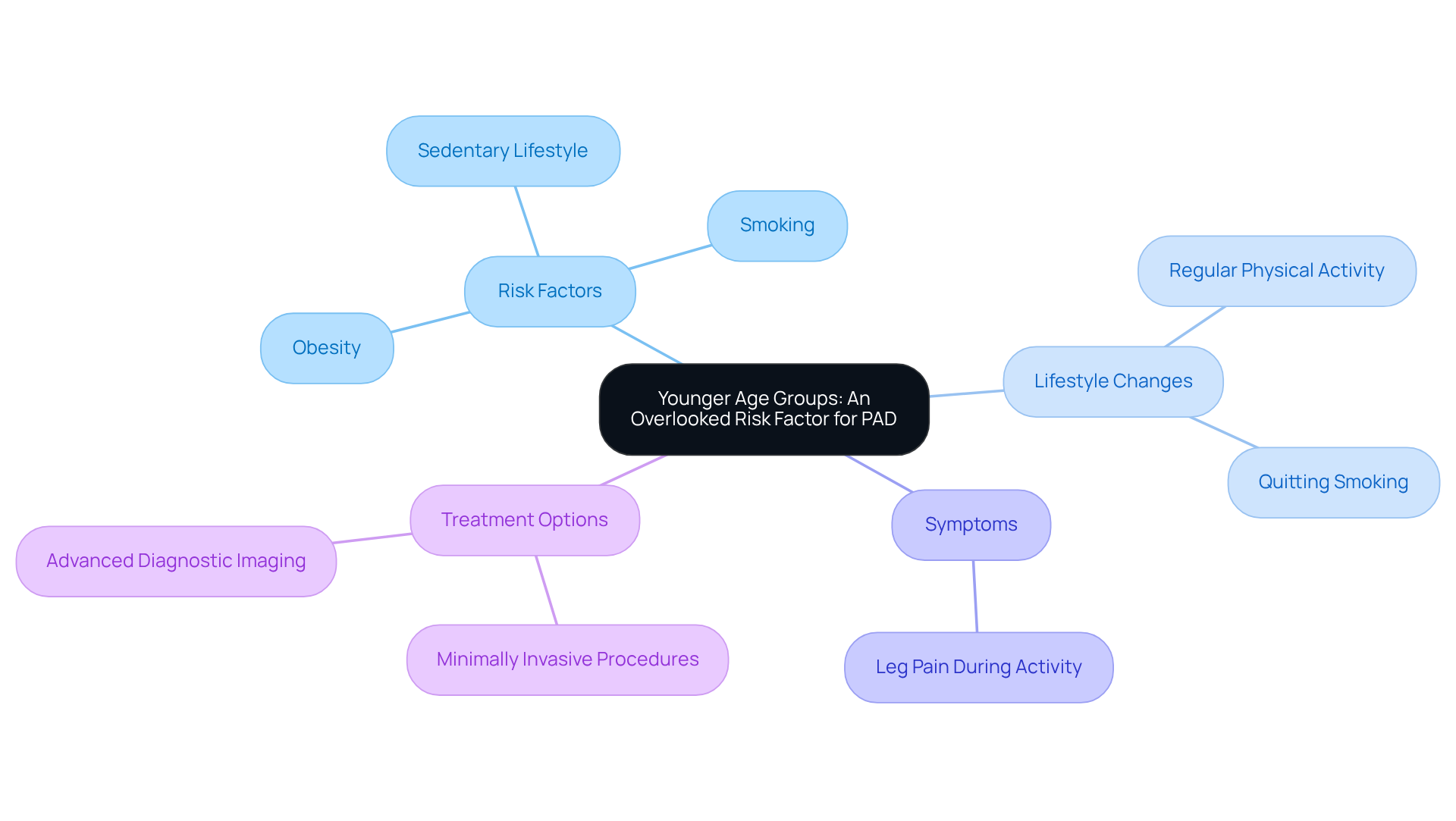
Diabetes poses a significant risk for developing peripheral artery disease (PAD), as PAD causes harmful effects on blood vessels. Elevated blood sugar levels can lead to atherosclerosis, a condition where plaque builds up in the arteries, narrowing them and restricting blood flow to the limbs. Have you ever wondered how this might affect your health? Studies indicate that individuals with diabetes are up to four times more likely to develop conditions that PAD causes compared to those without the condition. Among diabetic individuals aged 40 and above, the prevalence of PAD is about 11.2%, underscoring the seriousness of this issue.
This increased risk emphasizes the importance for those with diabetes to closely . Did you know that 70% of PAD cases are asymptomatic? This makes proactive screening essential. At Amavita Heart and Vascular Health, we provide advanced imaging capabilities and comprehensive evaluations tailored for high-risk patients, ensuring that those with diabetes receive the specialized care they deserve.
Regular checkups and proactive management strategies, including lifestyle modifications and adherence to medication, are vital for reducing the risks that PAD causes. Collaboration with medical professionals, such as endocrinologists and vascular specialists, is key in developing personalized treatment plans that address both diabetes and cardiovascular wellness. By effectively managing blood sugar levels and utilizing advanced cardiovascular care, patients can significantly enhance their vascular health and lower the risk of serious complications that PAD causes. Remember, you are not alone in this journey; we are here to support you every step of the way.
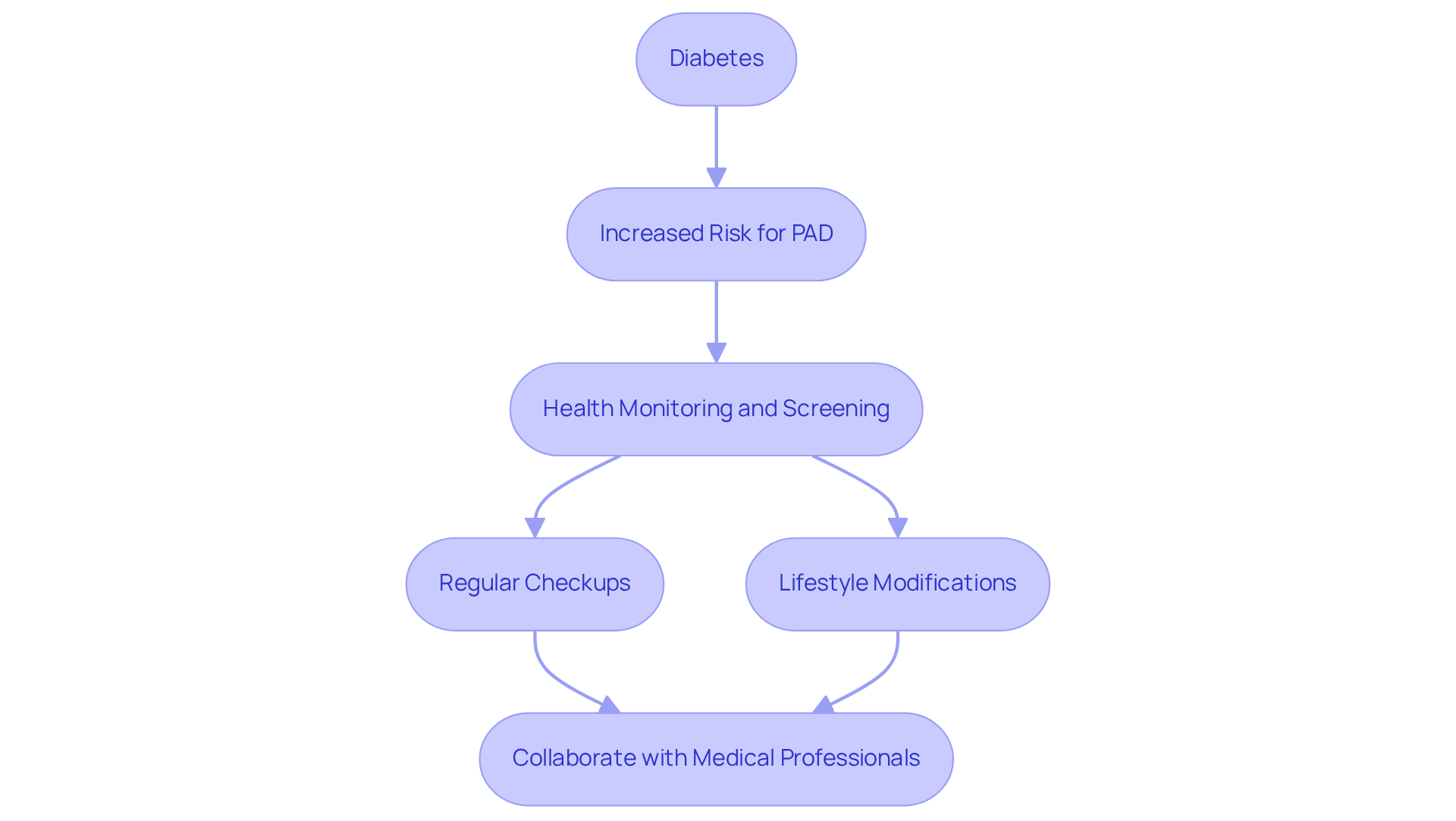
Smoking is a significant factor because it contributes to PAD causes, leading to plaque buildup in the arteries. The harmful substances in tobacco not only damage blood vessels but also disrupt circulation, leading to . Have you ever considered how smoking might elevate your chances of facing this condition? Research indicates that smokers with over 40 pack-years are fourfold more likely to experience PAD causes compared to non-smokers. Additionally, those with diabetes who smoke face the greatest risk for complications that PAD causes.
The encouraging news is that quitting smoking can lead to remarkable improvements in your vascular health. Just 20 minutes after you stop, your heart rate and blood pressure begin to decrease. Over time, your risk of PAD can significantly diminish. Studies reveal that individuals who quit smoking can see a 57% reduction in the risk of PAD causes within five to nine years. Cardiologists stress the importance of a comprehensive treatment plan that includes lifestyle changes, empowering those living with PAD to lead full and active lives.
As awareness grows about the long-term effects of smoking on vascular health, it’s crucial for older adults to understand the importance of quitting. Committing to quit not only enhances personal health outcomes but also supports broader public health efforts to alleviate the burden caused by PAD causes. Remember, you are not alone in this journey—there are resources and support available to help you take this vital step towards better health.

High cholesterol levels are a significant contributor to the development of Peripheral Artery Disease (PAD), as the factors that PAD causes include plaque formation in the arteries and restricted blood flow. If you’re among the approximately 8 million adults in the U.S. affected by PAD, it’s crucial to manage cholesterol to prevent its progression. Regular cholesterol screenings are essential for early detection and intervention, allowing healthcare providers to create tailored treatment plans that suit your needs.
At Amavita Heart and Vascular Health, we focus on providing targeted cardiovascular care for individuals at high risk. Utilizing advanced imaging techniques, we evaluate and monitor conditions such as PAD. These capabilities assist not only in recognizing blockages but also in guiding treatment choices, ensuring you receive the most effective interventions. Recent studies have highlighted the impact of cholesterol management on the causes of PAD. For instance, every 40 mg/dL increase in total cholesterol correlates with a 1.2 relative risk for claudication, a common symptom of PAD characterized by leg pain during physical activity. has been shown to decrease rates of lower extremity amputation in individuals with PAD, thereby emphasizing the necessity of managing cholesterol levels to address PAD causes.
Nutrition plays a vital role in managing cholesterol. A heart-healthy diet rich in fruits, vegetables, whole grains, and lean proteins can significantly help lower cholesterol levels. Our nutritionists at Amavita recommend incorporating foods high in omega-3 fatty acids, such as fish, and reducing saturated fats to enhance overall cardiovascular health. Regular consultations with our healthcare providers can assist you in creating personalized dietary plans that align with your cholesterol management goals.
Furthermore, ongoing studies continue to explore the connection between cholesterol levels and PAD, especially in older individuals. Research indicates that elevated levels of small LDL particles are associated with a greater likelihood of PAD causes, while maintaining healthy HDL levels can reduce this risk. Routine evaluations and tests for cholesterol and other cardiovascular factors are crucial for PAD prevention and management, ensuring you receive thorough care tailored to your specific needs at Amavita.
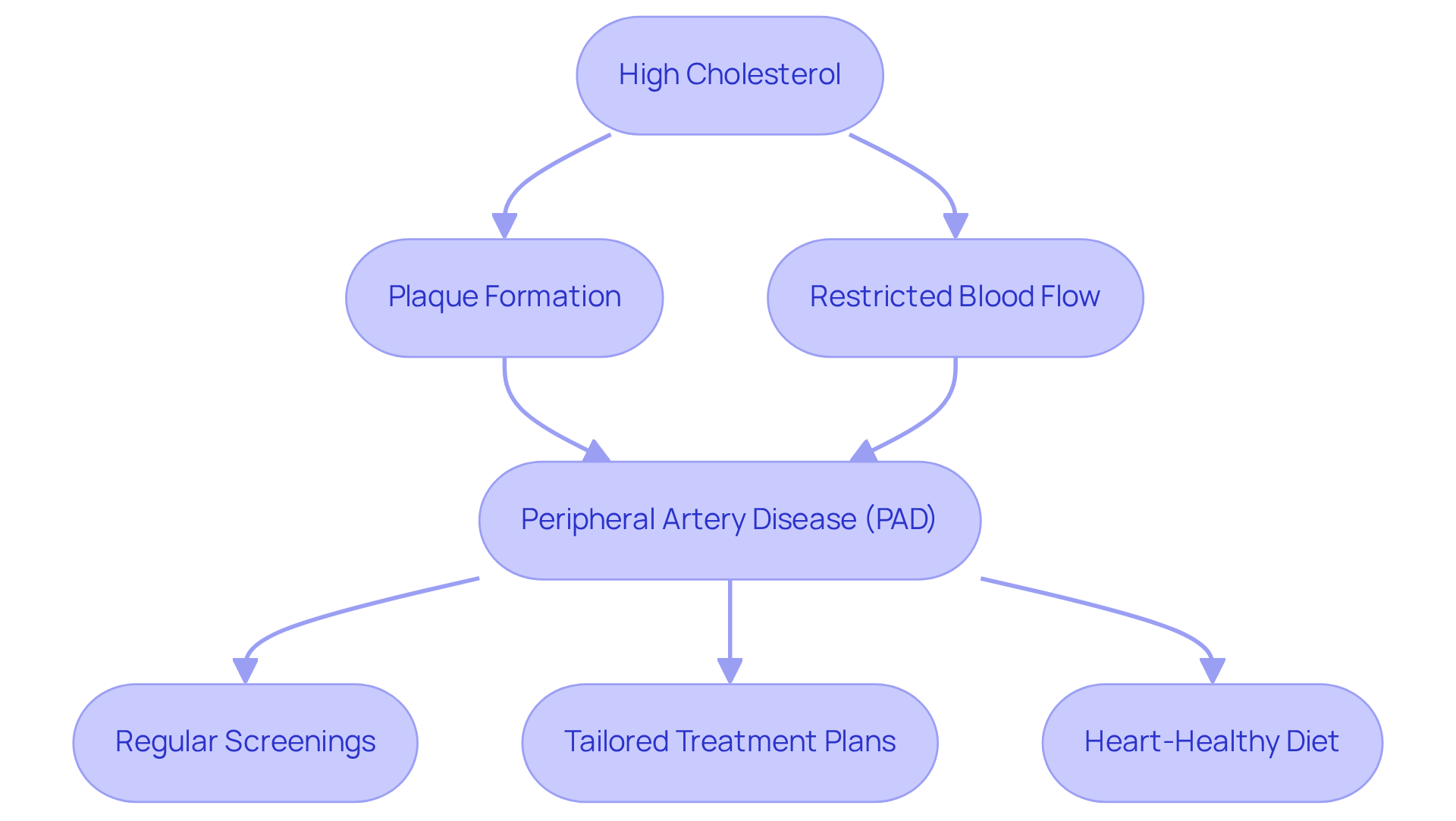
Hypertension, or high blood pressure, is a significant risk factor for peripheral artery disease (PAD), as the damage it causes to blood vessels is what PAD causes. This damage can lead to atherosclerosis, which increases the likelihood of PAD causes. At Amavita Heart and Vascular Health, we understand how concerning this can be. Regular monitoring and management of blood pressure are crucial steps in preventing vascular complications.
Our advanced imaging capabilities and comprehensive evaluations are designed to ensure that high-risk individuals, including those with hypertension, receive the targeted cardiovascular care they need. We take pride in our , which not only addresses hypertension but also incorporates sophisticated testing into a comprehensive care plan tailored to each patient's specific needs. This means you can feel confident that your health is in capable hands.
Ultimately, our goal is to enhance patient outcomes and provide the support you deserve. If you have concerns about your blood pressure or vascular health, we encourage you to reach out. Together, we can navigate this journey towards better health.
A sedentary lifestyle is a significant factor that PAD causes and is often overlooked in relation to Peripheral Artery Disease (PAD). Many may not realize that inadequate physical activity can lead to weight gain, increased cholesterol levels, and hypertension, all of which are PAD causes that heighten the risk of developing the condition. Did you know that up to 50% of individuals with PAD experience no symptoms? This highlights the importance of regular exercise as a preventive measure. Engaging in consistent exercise, even at moderate levels, can greatly improve circulation and reduce this risk.
Structured exercise therapy, particularly treadmill workouts, has been shown to enhance blood flow and alleviate symptoms associated with PAD causes. Experts recommend that individuals engage in physical activity two to three days a week for at least 20 minutes. Dr. Leithead emphasizes that this exercise should ideally help individuals in 'breaking a sweat.' This approach not only aids in managing the causes of PAD but also promotes overall vascular well-being, making it a vital part of any treatment strategy.
Consistent exercise can help individuals increase their walking distance, relieve leg pain, and develop alternative blood flow pathways, ultimately enhancing their quality of life. With over 150,000 amputations occurring each year in the United States due to PAD causes, it is essential for older adults to understand the on reducing risks to maintain their health and mobility. Furthermore, 25% of surveyed individuals recognize that PAD is associated with a higher likelihood of heart attacks and strokes, underscoring the need for greater awareness and proactive management. Remember, you are not alone in this journey, and taking steps towards physical activity can lead to a healthier, more fulfilling life.
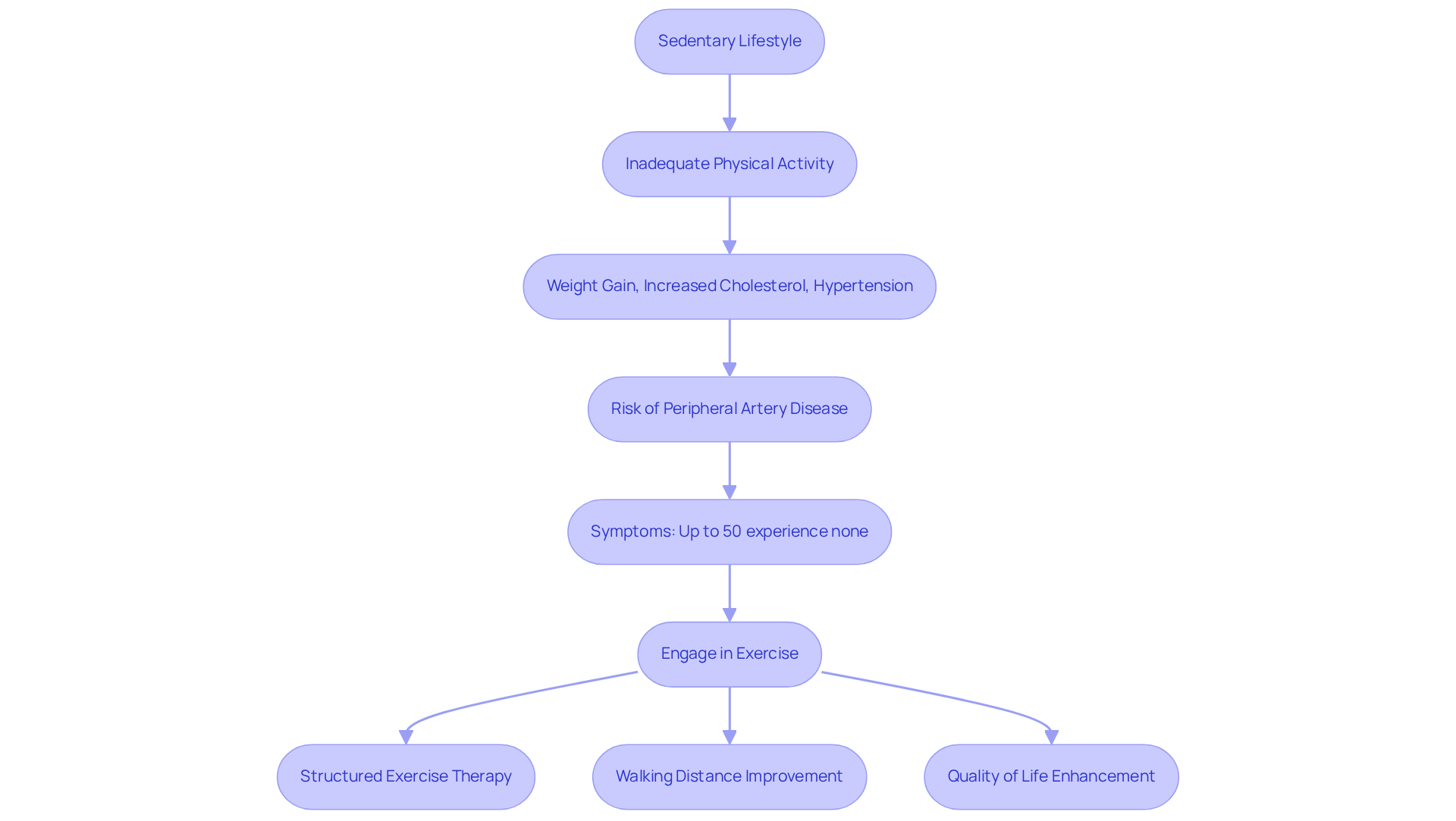
Obesity can be a significant concern for individuals, especially since PAD causes further complications in those facing peripheral artery disease. Excess weight may lead to elevated blood pressure, cholesterol levels, and inflammation, which can exacerbate PAD causes. Research indicates that those with a body mass index (BMI) greater than 30 kg/m² have a notably higher risk of functional decline and complications related to PAD. For example, the hazard ratio for incident PAD per 1-unit increase in BMI is 1.23. This highlights the importance of maintaining a healthy weight to help reduce these risks.
Effective weight management strategies for individuals with PAD often include a combination of dietary changes and regular physical activity. Engaging in supervised exercise therapy can improve walking ability and overall cardiovascular health. However, many individuals face challenges accessing these programs. It's crucial for patients to work closely with healthcare providers to develop a weight management plan that fits their personal needs and circumstances.
Recent studies have shown that even modest weight loss can lead to meaningful improvements in walking distance and quality of life for those whose quality of life is limited by what PAD causes. For instance, participants with a baseline BMI over 30 kg/m² experienced a more significant annual decline in walking performance compared to those with a BMI between 20 and 25 kg/m². This underscores the vital role of in preventing the PAD causes and enhancing overall wellness.
Dietitians often recommend focusing on a balanced diet that includes plenty of fruits, vegetables, whole grains, and lean proteins while reducing processed foods and sugars. By making these dietary adjustments alongside regular physical activity, individuals can effectively manage their weight and lower the risk of PAD-related complications. By prioritizing weight control, you can make significant strides in improving your vascular health and overall quality of life.
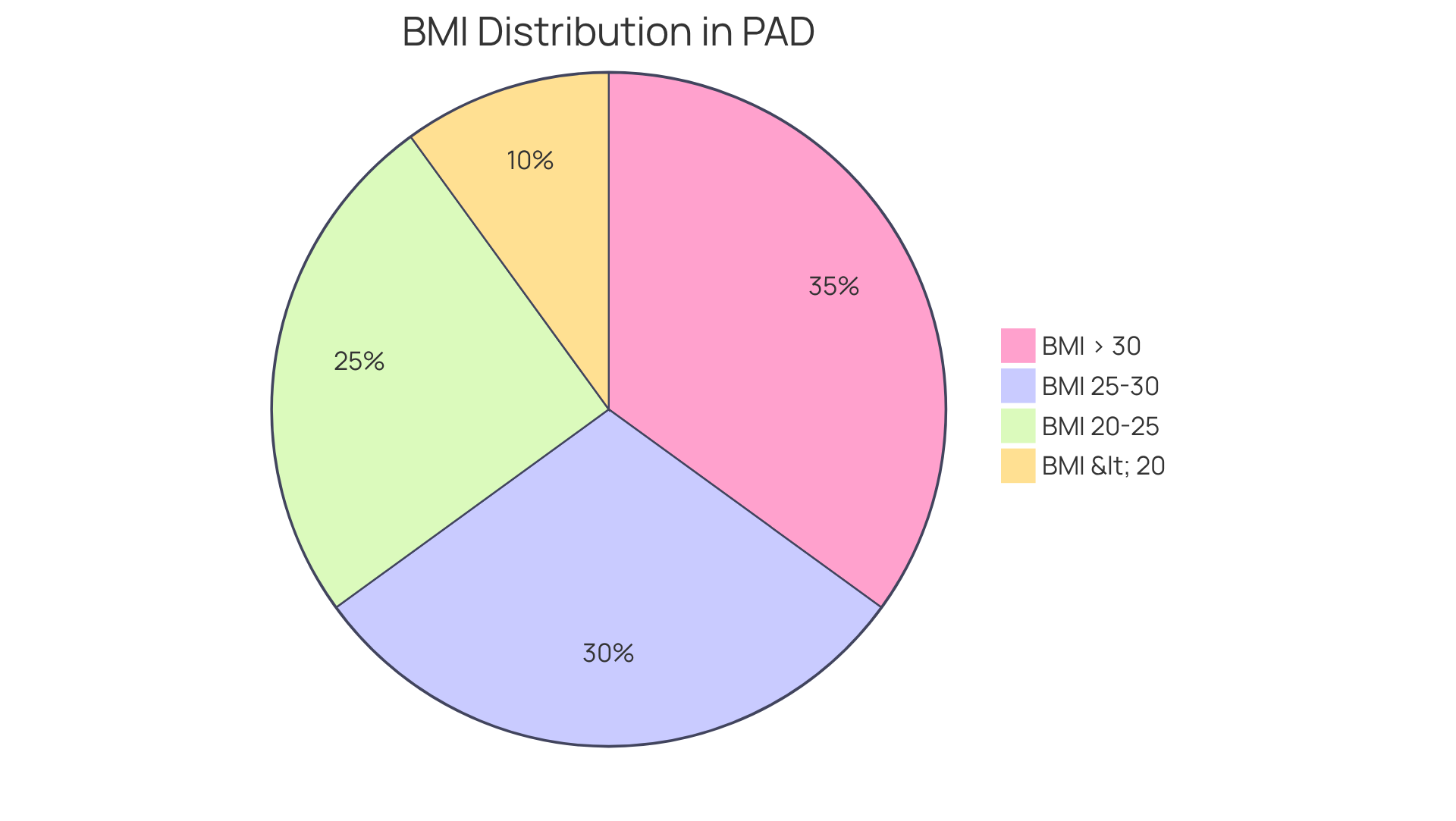
Genetics plays a significant role in the progression of Peripheral Artery Disease (PAD), and having a family history of cardiovascular conditions can considerably increase your chances of developing this condition. Research shows that families with a history of PAD often see a higher prevalence among siblings and children, highlighting the hereditary nature of this disease. If you experience symptoms of PAD, such as pain or cramping in your legs while walking that improves with rest, it’s important to talk openly with your healthcare provider about your family health history. This conversation can lead to personalized evaluations and tailored prevention strategies that best suit your needs.
For those with a strong family background in PAD, genetic counseling can be particularly beneficial. It offers valuable insights into potential risks and management options, helping you feel more informed and prepared. At Amavita Heart and Vascular Health, our compassionate specialists utilize advanced diagnostic imaging to identify any blockages and assess your cardiovascular health comprehensively. We provide minimally invasive procedures that can restore blood flow, significantly improving your walking distance and alleviating pain.
Understanding these is crucial for early intervention and effective treatment, particularly for older individuals who may be more susceptible to PAD causes. Additionally, it’s essential to consider other contributing factors, such as high blood pressure and obesity, as these can increase the risk of PAD causes. We encourage older individuals to consult with their healthcare providers about their family history and any potential contributing factors for PAD. By doing so, you can take proactive steps towards managing your health and benefit from the expert treatment options available at Amavita. Remember, you are not alone in this journey; we are here to support you every step of the way.
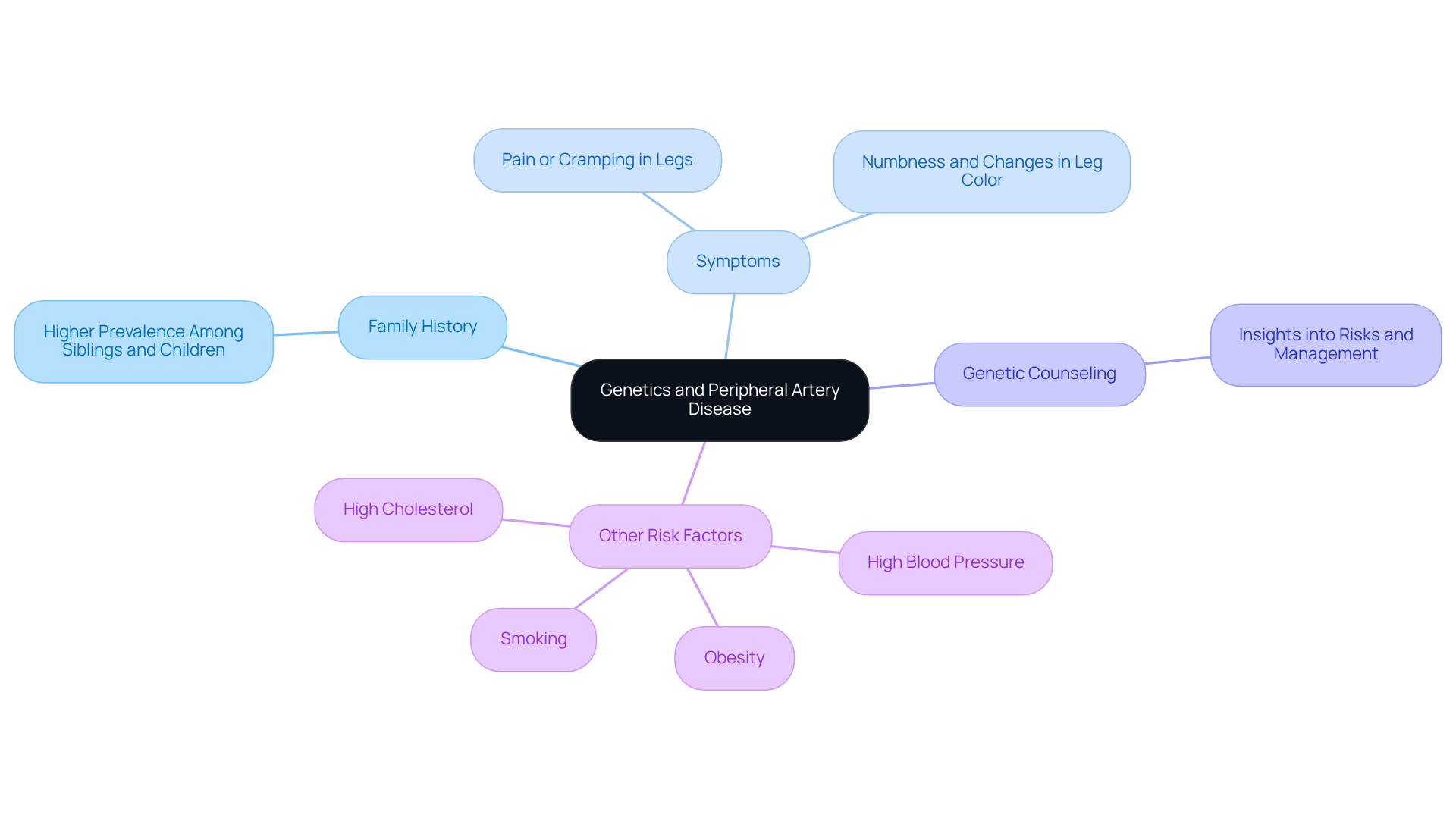
Chronic inflammation is a significant yet often overlooked factor that PAD causes, and it’s important to recognize how it may affect you or your loved ones. Conditions like rheumatoid arthritis and chronic infections can lead to ongoing inflammation, which can harm blood vessels and increase the likelihood of developing PAD causes. Research indicates that systemic inflammatory responses, including elevated levels of C-reactive protein (CRP), are linked to a greater risk of cardiovascular issues that PAD causes in those affected. In fact, having higher baseline CRP levels significantly raises the chances of the PAD causes developing, regardless of other factors. This means that inflammatory conditions not only worsen the progression of PAD but also contribute to the PAD causes of atherosclerosis, complicating cardiovascular health even further.
Managing underlying inflammatory conditions is essential for reducing the risk of conditions that PAD causes. Rheumatologists emphasize that effectively controlling inflammation can significantly lower the chances of complications that PAD causes. For elderly patients, understanding the link between chronic inflammation and how PAD causes various health issues is crucial. This knowledge can guide lifestyle modifications and treatment strategies aimed at improving vascular health and overall quality of life. Notably, PAD affects over 200 million adults globally, with an incidence of up to 20% in individuals over 70 years old. This statistic underscores the importance of addressing chronic inflammation in this population, as it can lead to better health outcomes and a more fulfilling life.
If you or someone you care about is experiencing symptoms or has concerns about PAD, it’s vital to reach out for support. Understanding how PAD causes relate to can empower you to take proactive steps towards better health. Remember, you are not alone in this journey, and there are resources and professionals ready to help you navigate these challenges with compassion and care.

Understanding the surprising causes of Peripheral Artery Disease (PAD) is crucial for elderly patients and their caregivers. This multifaceted condition is not just limited to older adults; it is increasingly seen in younger populations as well. By recognizing various risk factors such as:
individuals can take proactive steps toward prevention and management.
Lifestyle choices and underlying health conditions significantly influence the likelihood of developing PAD. Innovations in treatment at Amavita Heart and Vascular Health highlight the importance of tailored care and advanced techniques that prioritize patient comfort and outcomes. Through a comprehensive approach that combines awareness, early detection, and effective treatment, patients can improve their quality of life and mitigate the serious complications associated with PAD.
In conclusion, raising awareness about these unexpected causes and risk factors is essential for fostering better health outcomes for individuals at risk of PAD. Empowering patients with knowledge and encouraging lifestyle changes can lead to significant improvements in vascular health. It is vital to consult healthcare professionals for personalized strategies and interventions, ensuring that everyone can navigate their health journey with confidence and support.
What is Peripheral Artery Disease (PAD)?
Peripheral Artery Disease (PAD) is a condition characterized by narrowed arteries, which restrict blood flow to the limbs, often leading to symptoms like leg pain during physical activity.
Who leads the treatment team at Amavita Heart and Vascular Health?
The treatment team at Amavita Heart and Vascular Health is led by Dr. Pedro Martinez-Clark, who focuses on tailoring treatment plans to meet individual patient needs.
What innovative technology does Amavita use for treating PAD?
Amavita employs the Auryon Atherectomy System, which utilizes a 355 nm fiber laser to effectively treat complex lesions, including severe calcifications and chronic total occlusions.
What are the benefits of the minimally invasive procedures offered at Amavita?
The minimally invasive procedures reduce recovery times, enhance patient comfort, and often allow patients to return home the same day after their procedure.
What is the prevalence of PAD among older adults?
Studies show that PAD is prevalent among individuals aged 80 and older, with rates reaching 5.7% in women and 7.9% in men.
What lifestyle factors contribute to PAD in younger individuals?
Factors such as obesity, smoking, and a sedentary lifestyle contribute to an increased risk of PAD in younger individuals.
How many people aged 40 and above in the U.S. are affected by PAD?
Approximately 6.5 million people aged 40 and above in the U.S. are affected by PAD.
What are the classic symptoms of PAD?
Classic symptoms of PAD include leg pain during physical activity that eases with rest.
Why is diabetes a major risk factor for PAD?
Diabetes increases the risk of PAD due to elevated blood sugar levels leading to atherosclerosis, which narrows the arteries and restricts blood flow.
What percentage of PAD cases are asymptomatic?
About 70% of PAD cases are asymptomatic, making proactive screening essential.
What proactive strategies does Amavita recommend for managing PAD, especially for diabetic patients?
Amavita recommends regular checkups, lifestyle modifications, adherence to medication, and collaboration with medical professionals to develop personalized treatment plans.